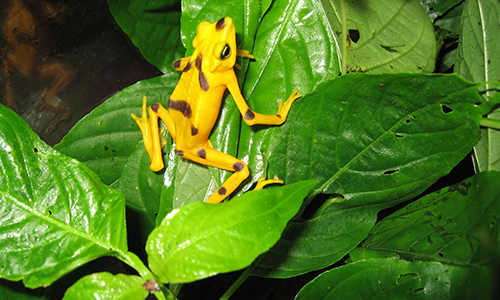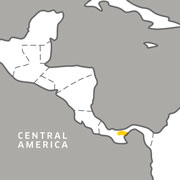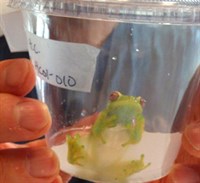Appearance:
The Panamanian golden frog is small and bright yellow with black spots on its legs and back. Females are generally larger than males, who are also a darker shade of yellow and brown. They have long front and back legs with four toes on the front and five in the back. Tadpoles have a coloration that matches the stream bottom, and as they develop into juveniles, they turn a dark green with brown and black spots. They don't turn into their trademark bright yellow until sub-adulthood. Their long legs make them excellent jumpers.
Size:
- Length: Females, 1.8 - 2.5 inches; Males, 1.4–2.5 inches
- Weight: Females, .15 - .5 ounces; Males, .1 - .4 ounces
Diet:
These frogs are insectivores, primarily feeding on bugs and invertebrates like beetles, ants, and flies.
Reproduction:
Panamanian golden frogs breed through a process known as amplexus, which may last for days or months. In this courtship, the male will jump onto the female’s back and hold on. In most species, the male will secrete a liquid containing sperm and fertilize the eggs as the female lays them. The golden frog's breeding season spans November through January, and females lay an average of 370 eggs in each clutch. Ribbons of eggs are laid in flowing water, after which they're incubated for seven to ten days and then hatch into tadpoles. Tadpoles have "suction cups" that allow them to attach onto the stream bottom without being swept away by the current.
Behavior:
These frogs are diurnal (active during the day) and only found near sources of running water. Once females reach adulthood, they migrate further into the forest and only return close to the water's edge during breeding season. Males stay by the stream year round, defending their territories and waiting for females to return.
These frogs communicate via a method called "semaphore," which consists of a series of signals made by waving their arms at one another.
The Panamanian golden frog is the most toxic within its group. Ingesting the poison may cause cardiac arrest, brain damage and severe muscle damage. Frogs aren't toxic until they reach adulthood, which is why their camouflage as juveniles is so vital to their survival.
Median Life Expectancy:
Unknown in the wild






